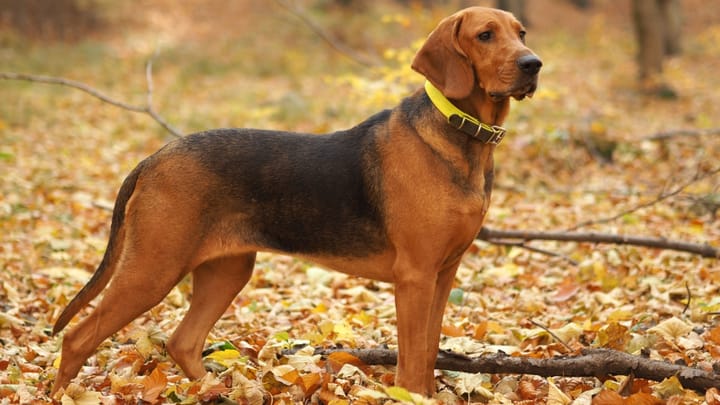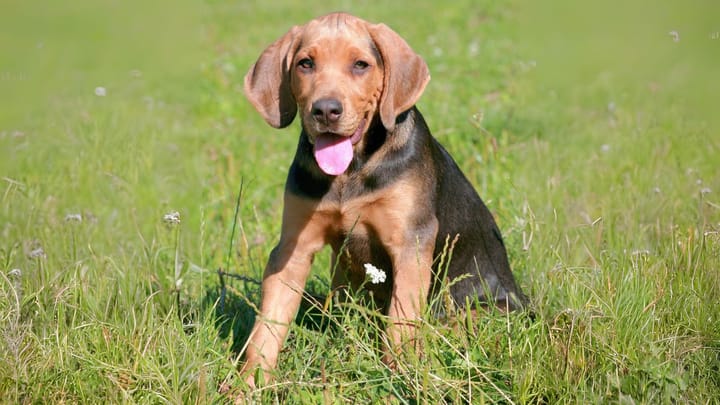Polish Hound
Other name: Ogar Polski


Who can resist these large dogs with soft ears like velvet? An ancient scent and hunting dog breed, the Polish Hound dates back many centuries, to ancestors who hunted and roamed the forests of Poland. In more current days, outside of his home country, he is more of a rarity. This gorgeous dog is energetic, gentle, clever and eager to please his owner. He certainly has the potential to make a brilliant family dog.
|
Life expectancy |
The Polish Hound has a life expectancy of between 12 and 14 years |
|
Temperament |
|
|
Size |
Medium
|
|
Adult size |
Female
Between 22 and 24 in
Male
Between 22 and 26 in
|
|
Adult weight |
Female
Between 44 and 57 lb
Male
Between 55 and 71 lb
|
|
Coat colour
Black, tan, or red, plus any colour combinations of these 3 colours. White markings are seen in some dogs. |
Red |
|
Type of coat
The Polish Hound sports a short, smooth double coat. With a thick undercoat layer and a waterproof topcoat. |
Long |
|
Eye colour
Brown/Amber |
Brown
|
|
Purchase price |
The Polish Hound costs between £450 and £650 |
One of the most notable things about the Polish Hound breed is his stunning, resonant voice. When trailing his quarry through difficult terrains and in harsh weather conditions, he will constantly bark, or sing as he gallops along, giving chase. The female dog can be spotted easily, because of her higher pitched call.
More details about the Polish Hound
Polish Hound: Origins and history
During the 13th century, the Polish Hound breed was created purely as a hunting dog. The first canines were produced by crossbreeding indigenous Polish dogs with the St. Hubert’s Hound. Although its exact ancestry isn’t documented, the breed was valued by Polish hunters for its hunting and scenting abilities.
The breed almost became extinct during World War II, but because two colonels revived the breed, the Polish Hound of modern day developed. The Polish Hound, or the Ogar Polski as it’s known in its native country, was given FCI recognition in 1966.
Physical characteristics of the Polish Hound
The Polish Hound is a large, athletic dog, with a wide-shaped face. His face has slightly wrinkled skin which actually makes the dog look very curious and appealing. The Polish Hound has a deep chest, waist tucked up and a low and long tail. His ears are heavy, pendulous, and velvety.
FCI classification of the Polish Hound
-
Group 6 - Scent hounds and related breeds
-
Section 1 : Scent hounds
Polish Hound: Characteristics
Polish Hound: Behaviour
Training a Polish Hound
The Polish Hound is a very quick and eager pupil. He learns willingly and easily especially if rewards are offered. The trainer needs to be patient and calm and above all, not to raise his voice to the dog during training sessions.
Polish Hound: Lifestyle
Breed compatibility Polish Hound
Polish Hound: Purchase price
The initial purchase cost of your Polish Hound will be between £450 to £650. In addition, extra monthly costs, including food, vet visits, and insurance, will be between £60 to £80.
Polish Hound: Grooming
This dog requires very little routine grooming and maintenance. His smooth, thick coat is almost self-cleaning. A weekly brush should collect any hair that the dog sheds.
Polish Hound: Health
There are no documented hereditary health issues affecting the Polish Hound. He certainly has a reputation for good health, but even so, because he is a hunting dog, he may come into contact with infectious diseases and parasites. As he is a deep-chested dog, he may be prone to gastric dilatation and volvulus, more commonly known as bloat. The average life expectancy of the breed is 12 to 14 years.
Just as with the majority of scent hound breeds, this dog is known not only for his strong disposition, but also for his excellent sense of smell and his stamina.
The Polish Hound is very adaptable to all climates, even heat.
The Polish Hound dog can contend with the most difficult weather conditions. He has the advantage of a waterproof coat to offer protection against wet and chilly weather.
If the recommended feeding instructions are followed, both as a puppy and an adult, the Polish Hound won’t grow too quickly or become obese in later life.
- Ear infections
- Hip dysplasia
- Gastric dilatation and volvulus (Bloat)
- Parasites
- Injuries sustained in the hunting field


